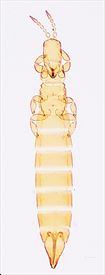

Antenna
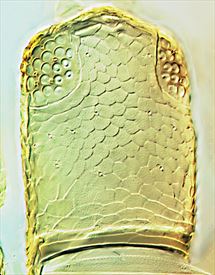

Meso & metanotum and abdominal tergite I
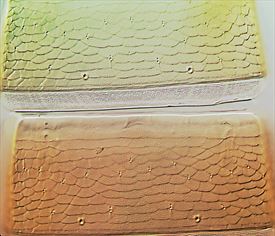
Tergites III-IV
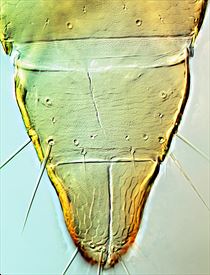
Female tergites VIII-X
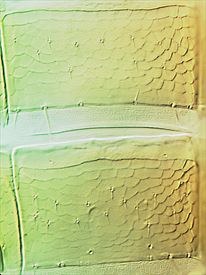
Sternites VI-VII

Hind tibia & tarsus
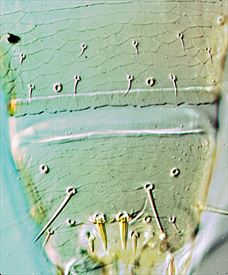
Male tergites VIII-IX
Distinguishing features
Both sexes wingless. Body and legs yellow, antennal segment VI shaded with brown. Antennae 6-segmented, VI twice as long as V, III–IV each with sense cone simple. Head longer than wide, without ocelli, without long setae. Pronotum weakly trapezoidal, without long setae. Meso and metanota transverse. Prosternal basantra with no setae; ferna almost continuous medially; meso and metafurca without spinula. Tarsi each 1-segmented. Tergites with 2–20 discal setae; tergite IX posteromedian pair of setae short, about 0.2 times as long as lateral pair; tergites and sternites without craspedum; sternites with many discal setae.
Male similar to female but smaller; sternites without pore plates; tergite IX with 2 pairs of stout thorn-like setae.
Related species
Four species of Aptinothrips are recognised, and A. rufus has distinctive 6-segmented antennae.
Biological data
Feeding and breeding on the leaves of grasses (Poaceae), and in New Zealand mainly on introduced European grasses.
Distribution data
Originally from Europe but widespread in New Zealand, this is one of the most common and widespread thrips in temperate areas throughout the world, including montane areas of tropical countries.
Family name
THRIPIDAE, THRIPINAE
Species name
Aptinothrips rufus (Haliday)
Original name and synonyms
Thrips (Aptinothrips) rufus Haliday, 1836: 445
Thrips (Aptinothrips) nitidulus Haliday, 1836: 446
Aptinothrips rufa connaticornis Uzel, 1895: 153
Uzelliella lubbocki Bagnall, 1908: 5
Aptinothrips intermedius Priesner, 1920: 52
Aptinothrips groenlandica Richter, 1928: 850
References
Mound LA & Walker AK (1982) Terebrantia (Insecta: Thysanoptera). Fauna of New Zealand 1: 1–113.
Palmer JM (1975) The grass-living genus Aptinothrips Haliday (Thysanoptera: Thripidae). Journal of Entomology (B) 44 (2): 175–188.